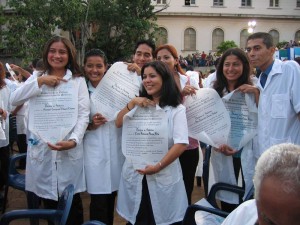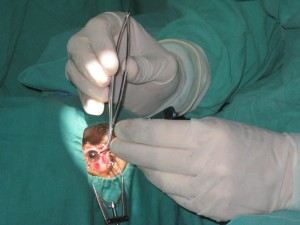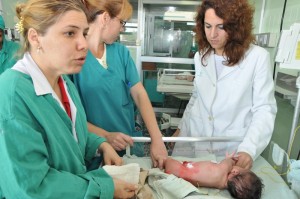Cuba’s Health Care Challenges

HAVANA TIMES — On Thursday, 5,694 young people from 59 countries in Latin America, Asia and Africa in Cuba received their diplomas certifying them as doctors. The last time I was at that international school, I ran into everyone from a Uruguayan compatriot of mine drinking mate to a young Mongolia woman washing her clothes.
This year the class was led in numbers by Bolivia, with 2,400 graduates; followed by Nicaragua, Peru, Ecuador, Guatemala and Colombia. Soon these doctors will return to their communities with the hope of joining the fight against diseases and ailments – but actually only some will succeed.
In many countries, medical schools have erected towering barriers against recognizing degrees from the Latin American School of Medical Sciences (ELAM). I know a Salvadoran woman who has spent years waiting for validation, despite her having studied a specialty.
Because of these limitations, some graduates leave their countries and immigrate to developed countries where they are recognized as general practitioners and allowed to specialize. Later they work with the same rights as a local physician.
This situation makes the impact of the project more modest than expected. Also, none of the benefiting countries provide financial support for the training, which means that the economic burden of thousands of foreign students is increasingly heavy on Cuba.
In the meantime, sources from the Cuban Ministry of Public Health confirmed to me that enrollment at ELAM will be reduced by half, and no one knows for sure how many more graduations will be held.
It’s a shame, because taking a young man or young woman from their community, turning them into doctors and returning them to treat their own people is a project that is very human. I verified that when I saw the ELAM graduates attending to the sick among the Kuna people in Panama.

The problem is that Cuba funds the program from the budget of the Public Health Ministry, and things there aren’t working well enough for the country to splurge on non-basic expenses. Hospitals suffer from chronic shortages resulting from the lack of money, wasted resources and corruption.
At this very moment, the director of a major hospital in the capital and scores of subordinates are in jail for having set up a “private business operation,” but using state resources. Through this, they charged for services that ranged from abortions to cosmetic surgery.
The matter shouldn’t surprise anyone, because the whole political class has a relative or friend who has had liposuction or breast implantation procedures performed. Even the Customs Office — so strict with other items — allows people to bring breast prostheses into the country without charging fees.
Seeing how silicone enhances a woman’s figure, one might think that it’s all worth the trouble, though this certainly wouldn’t cross the mind of the suffering patient who’s waiting for an operating room while the girls of show business and the mistresses of important people are getting their waistlines trimmed so they can fit back into their bikinis.
It appears that in the area of public health, a simple “adjustment of the model” won’t suffice. What it really needs is major reform to end the construction of useless construction facilities, the purchase of unusable equipment, the theft of food, the black market on medicines and corruption.
It would help to increase the salaries of doctors, respect the economic promises made to those who served on overseas missions, facilitate the entry of their belongings back into the country when they return, and give them the opportunity to buy new cars and create housing cooperatives.

One doesn’t have to look too far for the resources. It would be enough to spend a small part of what those same aid workers generate through their work in other countries. There are plenty of reasons why Cuban health care personnel should be the “spoiled” of society.
If there was a need to save even more, it would be sufficient to implement the agreements of the Communist Party Congress that call for an analysis of the expenses involved in every Cuban solidarity campaign (such as foreign health care assistance) and proposes that compensation for costs be collected, wherever possible.
With 70,000 doctors, Cuba has the human capital to support other peoples in the wake of disasters, but its economic resources are so scarce that it seems logical to seek financing. The exchange with Venezuela and coordination with Norway in Haiti are examples of where this is possible.
This premise could also serve to prolong the life of the Latin American School of Medicine. It doesn’t seem excessive to ask governments to cover the living expenses of their students and, especially, to ensure the recognition of their degrees.
—–
(*) An authorzed Havana Times translation of the original posted by BBC Mundo.






The claim that Cuban medical missions abroad are some kind of ” huge money-making operation” is highly misleading,inaccurate and denigrates the dedication of Cuban doctors..
The number of countries that pay regular salaries for Cuban doctors are only a few out of over 70 countries around the globe. Yes Venezuela and South Africa do pay salaries and part of those salaries help to subsidise so many poor countries that provide only accommodation,food and transport to Cuban medical teams.
I suggest youo check with Economist Intelligence Unit in the UK . re- Cuba’s estimated income from, medical services.
The estimated 2 billion dollars is a figure that includes many different medical services : treatment of thousands of foreign patients in Cuba/ sales of medical equipment and vaccines to over 40 countries /biotechnology joint ventures in China/ India and other countries.
Cuba ‘s humanitarian work abroad – -relief operations in earthqaukes viz Pakistan/Indonesia and many other places are examples of international solidarity.How about East Timor, and dozens of other poor countries -who cant afford to pay salaries to Cuban doctors?
Sure this island is not perfect. it has many economic problems.But its great achievement has been its willing to share its educational and medical achievements with the rest of the world. And unlike the US medical system,where health is a commodity in the market, Cuba promotes health as public service and a human right with free treatment of their patients.
With about half of Cuba’s 70,000 doctors abroad making money for the regime – the biggest source of foreign currency – all Cuba’s doctors are being used for is the keep the regime alive at their expense.
A fact Mr. Ravsberg seem to “forget” here.
References.
“It has also been an important source of foreign currency for Cuba, with earnings from the export of medical services, including 37,000 health workers overseas, estimated at more than $2 billion. Ms.
Hansing said that these days the Cubans typically ask host countries to pay a sliding scale that averages $2,500 per doctor, per month. But Haiti, she said, is one of a few countries that are not charged.”
Cuba Takes Lead Role in Haiti’s Cholera Fight
By RANDAL C. ARCHIBOLD
Published: November 7, 2011
http://www.nytimes.com/2011/11/08/world/americas/in-haitis-cholera-fight-cuba-takes-lead-role.html
The Cuban government manages these statistics with great discretion, but all sources conclude that there are about 40,000 of their health care workers serving overseas – most of them in Venezuela, but also in 69
other countries.
According to studies by centers specializing in the analysis of the Cuban economy, health care personnel bring in $5 billion USD annually, a significant figure when compared with the $2.4 billion received from
tourism or the $1.2 billion from remittances.
The doctors spend periods of two years working in one country or another, during which time they receive part of their salary there while another part goes to their family in Cuba (who are paid in regular pesos
and convertible pesos, and are given a discount card to make purchase in stores). Likewise, on their return to Cuba, these workers are allowed to import a large amount of goods with them.
However, the salaries received by these doctors represent a small part of what the Cuban contracting company charges customers who demand their services. This means the bulk of the money goes into the state treasury, making it one of the government’s highest profit-generating activities.”
May Day in Cuba: The Doctors Out in Front
May 2, 2012
http://www.havanatimes.org/?p=68998
(3)”The income to Castro’s purse from this “doctor diplomacy” in Zimbabwe alone is estimated at $1.2 million (U.S.) per month.”
Gaither C. Diserción en Zimbabwe empaña la “diplomacia médica” de Castro. El Nuevo Herald, June, 12, 2000.
“funds were allocated to Sierra Leone (R24 million) to fund 20 Cuban doctors to offer medical services”
South Africa: SA allocates R268m in aid to 19 countries
http://7thspace.com/headlines/416664/south_africa_sa_allocates_r268m_in_aid_to_19_countries.html
“I think medical services will have replaced tourism as our most important source of revenue in 2005,” said Garcia, who directs the Cuban Economy Study Center at Havana University.
Source :”Cuba’s medical services becoming major moneymaker”, South Florida Sun Sentinel, Dec.18 2005.
See: http://groups.yahoo.com/group/CubaVerdad/message/19469
Yes Moses, there are differences between the medical practices and quality, comparing Cuban ELAM graduates with the assumed standard in the US. AS you point out at the end, the comparison that is most real is between no doctors and a variety of mostly highly motivated Cuban trained doctors. So they are younger and been in school for shorter times. That does not automatically prove they are lesser in quality. Doctors who are worth the name, keep on learning and are very human, having good and bad days.
We in the US where money is too often King, know of lousy doctors who have been trained for years, but are too rushed to give good care. I know of many such doctors and on a few who take the time to listen or get to know their patients. The Cuban model practiced by young doctors in poor countries where they are not a “godsend,” the result of politics and policies that are the reverse of medicine for profit.
So I want to thank Fernando Ravsberg* for this compassionate article. Yes, lets see if we can improve and maintain good medical practices. Americans in the US can only imagine the home visit, the visiting nurse (France and other European countries) visits that take the time needed, and equal treatment regardless of their wealth or lack of it.
Of course Cuba is imperfect and so are most revolutionary efforts, but that is the point. Only by trying to improve things for the whole community can we avoid the extreme and growing inequality that is worshiped in the US.
Here in the US we have a sort of medical lottery. You can go to an emergency room and eventually you will get seen and discharged as quickly as possible. Have money or insurance, you get better treatment and have enough money to pay extra, thousands of dollars, and you may get “boutique” medicine where you go to the head of the line and the doctor “loves” you. There are good doctors and other health care personnel everywhere. But we should make it possible for them to do an increasingly humane and quality job. Where the emphasis is on prevention, health education, community care and yes, making it a honored profession. I could go on and on, but clearly we have a lot to learn from each other.
Dear HT,
it is sad news about cutbacks at Elam.I agree with Fernando that the government needs to develop more third party funding and support.
In addition to Venezuela and Norway,Cuban medical missions in Africa receive support from South Africa.But many other countries should doing more to help out cash-strapped Cuba, that has so generously shared their health resources with so many poor nations.
Eureka Films have almost completed a film about the training of South African medical students in Cuba and how they are preforming back home as qualified doctors working inside the public health system and willing like Cuban doctors to serve in remote parts of their country.
More details are available from my report for Al Jazeera TV ‘Cuba Exporting Health-care to Africa ‘
It is interesting to note that the life expectancy in Cuba currently is 77.08 years; in the U.S.A. it is 78.00 years. In other words, a virtually, err, “dead heat!” The U.S.spends many more times per capita what Cuba spends (and, in fact, is able to spend); hence, Cuba is getting far more bang for its buck than our own dysfunctional system.
Cuban doctors have no doubt been a blessing to many third world countries (and some developed countries too) but there is a significant difference in the training that a Cuban-trained doctor received in comparison to doctors in the US for example. An 18 year-old Cuban (or ELAM student) with decent grades in high school can be accepted in the medical training school and 6 years later can call himself a doctor at 24 years old. In the US only those graduates with the highest marks who have received their university undergraduate degrees in a related field of study and after scoring well on their MCATS are accepted into US-certified medical schools. This means they are usually at least 22 years old before beginning medical school. Four years of medical school, and one year of interning later, US medical students become “doctors”. Again, they are typically at least 27 years old at this point. You are not a “real” doctor in the US until you finish your residency which depending on the specialty is two to four more years. For an indigenous indian in Bolivia, a Cuban-trained doctor is a godsend. His alternative is none at all. But for most people, it is reasonable to expect at least two more years of medical training for any Cuban-trained doctor in order to be licensed to practice medicine.